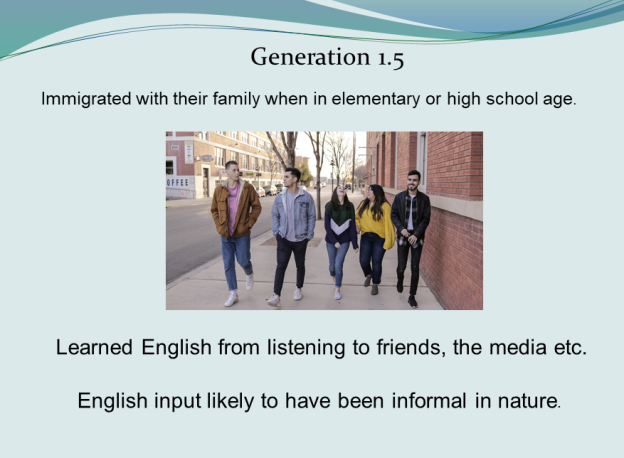
(This posting includes a handout which you are welcome to use with your students.)*
In our college, there was a category of ESL students who stymied the instructors. They were fluent speakers but continually struggled with basic the grammar on writing tasks. Any ESL program that has immigrant students will probably have these types of students described as “ear-learners” or Generation 1.5.
Gen 1.5 students are sort of between first generation and second generation immigrant. They immigrated with their family when they were elementary or high school age.
A growing number of these students indicate a goal of obtaining a college degree. However, unfortunately, many of them struggle to make the transition from studying basic English skills in ESL courses to taking academic ESL and mainstream academic courses.
Among those who do apply to colleges, a considerable number do not meet the minimum standards for writing and are thus not accepted.
I, along with two colleagues, were able to get a grant a few years ago to study these students and to develop an approach to helping them learn grammar for writing by taking into consideration their special learning styles.
In this posting,
- I’ll describe these students and their learning styles.
- I’ll also explain the type of materials and include examples that we used with them.
- And finally, I’ll summarize the very positive results that we got from the study.
The Students
Student profiles: Immigrant students (Generation 1.5) v. international students
Immigrant students
As a group, immigrant students share some common characteristics. When at home—or with friends, either on or off campus—they generally speak a language other than English (Rodby, 1999). They also tend to have learned what English they know by ear, i.e. through input from listening to the media, friends, salespeople, teachers, and work colleagues. Because their English world has been, to a great extent, an aural one, many of them manage well in situations where they can rely on their fairly well-honed skill of listening. However, the English input that they have been “hearing” is likely to have been informal in nature. In turn, written work that they produce for their courses may have a conversational quality to it. Add to that the fact that each individual is likely to have developed his/her own set of “rules” about how English is structured—rules that are frequently mistaken (Reid, 1998).
In sum, many immigrant students tend to be aurally-oriented learners of English who interact in their native language on a regular basis, who have absorbed a particularly informal version of English, and who are likely to have developed their own system of rules that govern how they structure the English that they generate.
International students
International students comprise another large group of language-learners enrolled in pre-college and college coursework. Unlike many immigrant students, however, international students are likely to have studied English in their home countries before coming to the U.S. As such, before they arrive here, they are already familiar with both the terminology and the grammatical rules of English.
The importance of the distinction made above, between immigrant students and international students, will be discussed later in this posting.
Insights shared by one (real) student, Mimi
Mimi, an immigrant student from Taiwan, enrolled in a top-level, pre-college writing course that was taught by one of the ESL instructors at my college, Whatcom Community College (WCC). In many ways, Mimi’s story was a typical one. Her family moved to Washington state where, despite the fact that her English skills were limited, she was enrolled in middle school, and throughout middle school and high school, she attended regular classes with the American students. After graduating, Mimi placed into my Academic ESL reading-writing program at WCC. It was quickly evident to me that she was bright and motivated. Her classmates were international students, who, unlike Mimi, had studied the terminology and grammatical structure of English before coming to WCC. Nevertheless, Mimi was a better reader than them; she also put more effort into editing her written work than did most of the others. However, while the written work of her classmates improved, Mimi’s showed little or no progress. She was diligent and thorough in every assignment, but she was getting nowhere; the same mistakes resurfaced again and again, and this confounded her teachers.
One day, halfway through that pre-college course, while working with Mimi, I altered slightly the nature of their grammar discussion, and, in so doing, discovered some revealing insights into how she thought.
She and I were focused on this sentence, which she had written in her assignment that day:
- He didn’t found his money yesterday.
Rather than remind Mimi of what grammar rule applies when forming the simple past tense, that day, I asked her why she had chosen to use the past form, found, in “didn’t found.” She explained that she had, in fact, spent a long time thinking about it before opting for “found.” She added that, at first, she had thought the verb should be didn’t finds since the subject was he. However, in the end, she said she had decided to use found because the event happened in the past. Obviously, she had assumed that the rule was: When writing about the past, all verbs should be formed in the past—not only auxiliary verbs but base verbs as well. In this instance, Mimi displayed a characteristic described by Reid, above, of the typical immigrant student; she had developed a grammar rule of her own, and it was wrong.
Then, on another assignment, Mimi revealed another characteristic of the immigrant-student population; she made a grammar mistake because she had learned the language by ear and, consequently, didn’t recognize her own mistake because, to her, it “sounded right.”
In this case, Mimi wrote:
- He avoided drive at night.
She was unaware that the gerund form, driving, should follow the verb “avoid” because she had never heard the –ing pronounced by those around her. In fact, when the instructor explained that she needed “driving,” she was surprised because, she said, “avoided driving” sounded strange. For many of these aural learners, as time passes, errors such as this one can become fossilized, i.e. internalized permanently as “their version” of how English is structured. This probably results from the fact that they have been able to navigate successfully through everyday life via their own “non-standard” English system, and this has led them to assume that it is correct (Reid, 1998). Unfortunately, these engrained misassumptions of how English is formed can lead to difficulties once they enroll in college.
My experience with Mimi was the impetus to research how ear-learners have learned English and to develop an approach and materials that will incorporate their unique abilities to learn grammar.
The need for a new approach to teaching Gen. 1.5 students
Many writing instructors can relate to one mainstream instructor’s observation that immigrant students can fill in grammar worksheets with ease. This may be because these students are good at detecting the patterns involved, which opens up the risk that exercises of this nature could be done in a mindless manner. However, grammar rules that students apparently knew well when doing exercises don’t transfer to their longer written work, where mistakes surface that didn’t appear in their exercises (Hartman and Tarone, 1999).
In contrast, the material utilized in this study was designed to actively involve students’ analytical skills; this is not material to be done mindlessly.
Aspects of the study’s approach to teaching English terminology and syntax:
Aspect 1 Inductive rather than deductive thinking: Most ESL grammar books approach their instruction in a deductive manner. That is to say, a rule is given and students apply it to exercises. However, for immigrant students, who, as ear-learners, have learned English intuitively (Harklau, Siegal and Losey, 1999), an inductive approach could be more effective. The materials used in this study provided examples and exercises that, through a progression of steps, led students to intuit the rules that govern those examples. This aspect is based on the beliefs (1) that students will internalize the rules more efficiently if they have intuited (or formed) the rules themselves; and (2) that students who have established their own understanding of a rule are more apt to later apply it to what they write.
Aspect 2 Analytical rather than pattern practice: As was noted above from Hartman and Tarone, students who can follow patterns and fill in grammar exercises may still not be able to apply rules that they have practiced when doing longer written assignments. The material used in this study was created in a way that would encourage students to approach their work in a meaningful (analytical), not mindless manner. For this aspect, it is theorized that, to help students internalize a grammar rule, they should be given the opportunity to analyze and explain on their own why a specific grammar rule would apply in a certain case.
Aspect 3 Multi-sensory rather than visual only: As ear-learners, immigrants have acquired much of what English they know by listening and speaking. The grammar instruction for this study included oral/aural components. It is assumed that this type of student will find grammar tasks that include oral/aural components to be particularly helpful and meaningful.
Aspect 4 Paragraph-level, rather than just sentence-level, application: Each lesson in the study culminated with an assignment to write a paragraph. The underpinning here is that students will benefit from generating, not only at the sentence level, but at the paragraph level as well.
Aspect 1: Inductive rather than deductive thinking.
For example:
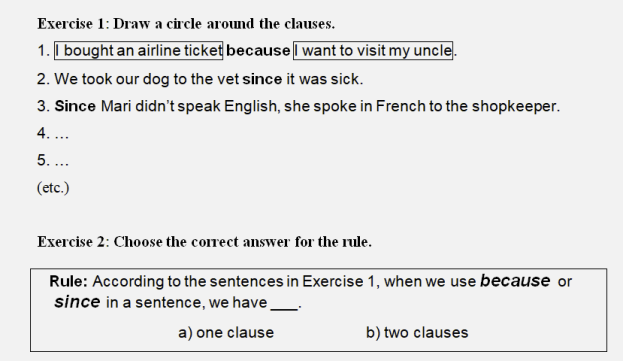
Aspect 2: Analytical rather than pattern practice
For example:
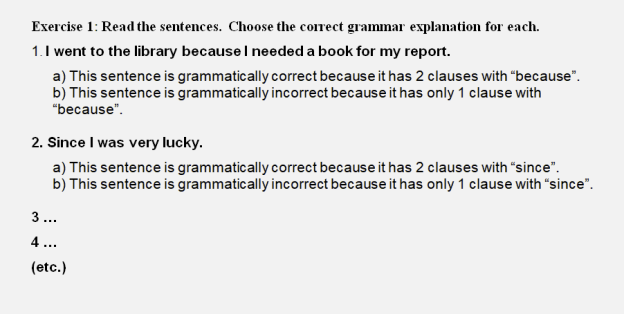
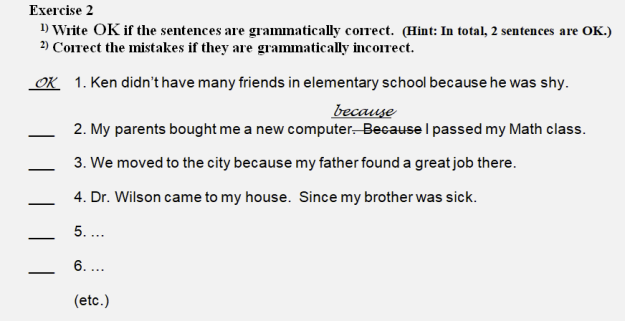
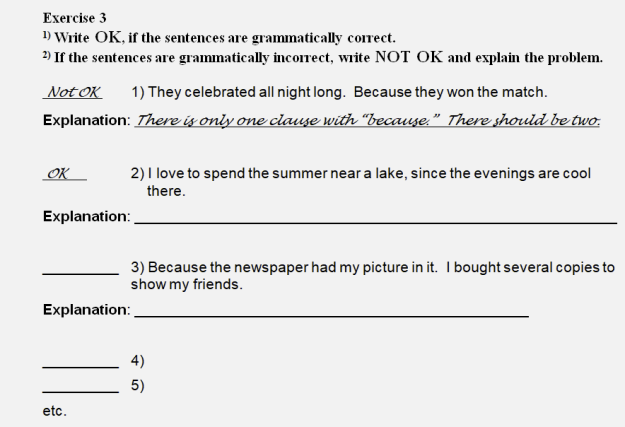
Aspect 3: Multi-sensory rather than visual only
For example:

To see the “Grammar Group Review” activity mentioned just above, see • Engaging Grammar Group Activities (Even For Hesitant Students)
Aspect 4: Paragraph-level, rather than just sentence-level, application
For example

The four aspects above form the basis for The Grammar Review Book The Grammar Review Book: Discovering and Correcting Errors.
Sample Units
Here is a link to a sample unit about compound sentences that demonstrates an integration of the four aspects above. Gen 1.5 sample unit Unit 8 Compound Sentences
Sample Mistakes: He felt ill he went to the doctor. // He felt ill, he went to the doctor.
Here is a link to a sample grammar group activity for these students. Gen 1.5 grammar group review sample unit
For a grammar book designed especially for Gen. 1 students and ear-learners, see Pro Lingua Learning Grammar Review Book.
Summary of the Results of the Study
The instructor who used these materials reported that her students had a positive reaction to the approach that the text took to grammar instruction and they remained remarkably motivated throughout the course. For example,
1) class attendance improved,
2) students turned in homework assignments more regularly than had been the case with previous groups,
3) small-group discussions were lively as the students worked together to problem-solve while progressing through the material.
At the start of the study, there was some concern that the grammar level of the material would be too low for the students in the class. The materials began with simple lessons that asked them to identify nouns, verbs, and subjects and continued from there with basic practice with verb tenses and forms. The ESL competencies indicate that students at this level should be working toward proficiency using present perfect tense, passive voice, conditionals, and complex sentence structures. It was clear after completing the initial units of the text that the students had many gaps and misconceptions about even some very basic grammar rules. (It should be noted that even the students whose writing level was too high at the start of the course to qualify them for this study chose to complete the grammar work with the rest of the class. This was another indication that the approach must have been engaging.) Even before the midpoint of the course students began observing that they were seeing improvement in their own writing. They often commented that, in the past, although they felt that they could successfully fill in grammar worksheets, either they still had misunderstood some grammar rules or they had never known what they were at all.
It should also be noted that of the 20 students in the class, three students who had previously expressed no interest in attending academic classes changed their minds during the course. In fact, two of them began academic coursework in the spring of 2005, and the third will start in summer. The instructor felt convinced that a firmer grasp of grammar may have bolstered their self-confidence and inspired them to enroll.
References
Brodkey, D., & Young, R. (1981). Composition correctness scores. TESOL Quarterly, 15, 159-167.
Ferris, D.R. (1999). One size does not fit all: Responses and revision issues for immigrant students writers. In L. Harklau, K.M. Losey, & M. Siegal (Eds.), Generation 1.5 meets college composition: Issues in the teaching of writing to U.S.-educated learners of ESL (pp. 143-157). Mahwah, NJ: Earlbaum.
Harklau, L. (2000). Generation 1.5 students and college writing. ERIC Clearinghouse on Languages and Linguistics. http://www.ericdigests.org/2004-4/writing.htm.
Harklau, L., Siegal, M., & Losey, K. (1999). Linguistically diverse students and college writing: What is equitable and appropriate? In L. Harklau, K.M. Losey, & M. Siegal (Eds.), Generation 1.5 meets college composition: Issues in the teaching of writing to U.S.-educated learners of ESL (pp. 143-157). Mahwah, NJ: Earlbaum.
Hartman, B. & Tarone, E. (1999). Preparation for college writing: Teachers talk about writing instruction for Southeast Asian American students in secondary school. In L. Harklau, K.M. Losey, & M. Siegal (Eds.), Generation 1.5 meets college composition: Issues in the teaching of writing to U.S.-educated learners of ESL (pp. 99-118). Mahwah, NJ: Earlbaum.
Kehe, D. & Kehe, P. (2004). Grammar Review Book. ProLingua Associates: 2006.
Reid, J. (1998). “Eye” learners and “ear” learners: Identifying the language needs of international students and U.S. resident writers. In J. Reid, & P. Byrd (Eds.), Grammar in the composition classroom (pp. 3-17), New York: Heinle & Heinle.
Rodby, J. (1999). Contingent literacy: The social construction of writing for nonnative English-speaking college freshmen. In L. Harklau, K.M. Losey, & M. Siegal (Eds.), Generation 1.5 meets college composition: Issues in the teaching of writing to U.S.-educated learners of ESL (pp. 45-60). Mahwah, NJ: Earlbaum.
David Kehe
*About the free-download materials. During my 40 years of teaching ESL, I have had many colleagues who were very generous with their time, advice and materials. These downloads are my way of paying it forward.